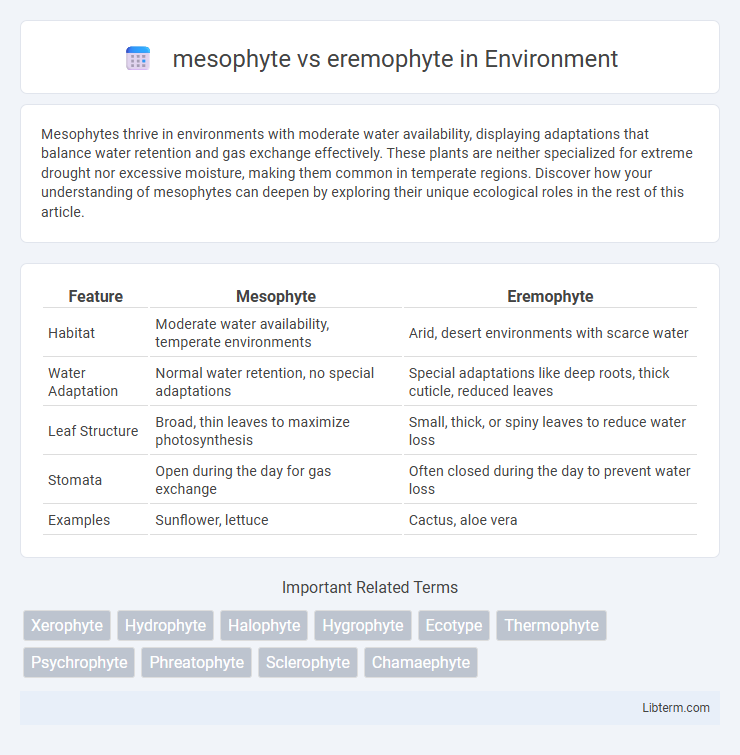Mesophytes thrive in environments with moderate water availability, displaying adaptations that balance water retention and gas exchange effectively. These plants are neither specialized for extreme drought nor excessive moisture, making them common in temperate regions. Discover how your understanding of mesophytes can deepen by exploring their unique ecological roles in the rest of this article.
Table of Comparison
| Feature | Mesophyte | Eremophyte |
|---|---|---|
| Habitat | Moderate water availability, temperate environments | Arid, desert environments with scarce water |
| Water Adaptation | Normal water retention, no special adaptations | Special adaptations like deep roots, thick cuticle, reduced leaves |
| Leaf Structure | Broad, thin leaves to maximize photosynthesis | Small, thick, or spiny leaves to reduce water loss |
| Stomata | Open during the day for gas exchange | Often closed during the day to prevent water loss |
| Examples | Sunflower, lettuce | Cactus, aloe vera |
Understanding Mesophytes and Eremophytes
Mesophytes are plants adapted to environments with moderate water availability, exhibiting features like broad leaves and well-developed root systems to optimize water uptake and photosynthesis. Eremophytes, in contrast, thrive in arid and desert habitats, possessing specialized adaptations such as reduced leaf surface area, thick cuticles, and deep or extensive root systems to minimize water loss and maximize water absorption. Understanding mesophytes and eremophytes involves analyzing their physiological and anatomical traits that enable survival in distinct moisture conditions.
Key Environmental Adaptations
Mesophytes thrive in moderate moisture environments with well-balanced water availability, featuring adaptations like broad leaves and extensive root systems to optimize water uptake and gas exchange. Eremophytes are specialized for arid and desert conditions, exhibiting key adaptations such as thick cuticles, reduced leaf surface area, deep or extensive root networks, and CAM photosynthesis to minimize water loss and maximize water storage. These distinct environmental adaptations enable mesophytes to maintain metabolic functions in stable moisture environments, whereas eremophytes survive extreme droughts through efficient water conservation and usage strategies.
Morphological Differences
Mesophytes exhibit broad, flat leaves with well-developed cuticles and stomata optimized for moderate water availability, whereas eremophytes display reduced leaf surface area, thick cuticles, and sunken stomata to minimize water loss in arid environments. Mesophytic roots are typically shallow and widespread, while eremophytes possess deep, extensive root systems for accessing scarce underground moisture. The structural adaptations in eremophytes include succulent stems or leaves and protective trichomes, contrasting with the thinner, less specialized tissues of mesophytes.
Water Requirements and Management
Mesophytes require moderate water levels and thrive in environments with consistent soil moisture, relying on regular rainfall or irrigation for optimal growth. Eremophytes are adapted to arid conditions, exhibiting specialized water management strategies such as reduced leaf surface area, thick cuticles, and deep root systems to minimize water loss and maximize water uptake. Efficient water use in mesophytes involves balanced hydration, whereas eremophytes employ drought tolerance and water conservation mechanisms to survive extreme dryness.
Habitat and Geographic Distribution
Mesophytes thrive in moderate habitats with adequate water availability, commonly found in temperate regions and fertile plains across North America and Europe. Eremophytes adapt to arid environments characterized by scarce water, predominantly occupying desert and semi-desert areas such as the Sahara, Arabian Peninsula, and parts of Australia. These contrasting habitats drive the distinct geographic distribution patterns tied to each plant type's water requirements and survival adaptations.
Root System Comparisons
Mesophytes typically have well-developed, fibrous root systems that efficiently absorb water from moderately moist soils, supporting their growth in environments with balanced water availability. Eremophytes possess deep, extensive taproot systems adapted to arid conditions, enabling access to deep underground water sources and enhancing drought resistance. The structural differences in root systems reflect each plant's adaptation to their respective moisture regimes, optimizing water uptake and survival.
Physiological Adaptations to Stress
Mesophytes exhibit physiological adaptations such as moderate stomatal regulation and efficient water use to maintain homeostasis under variable moisture conditions. Eremophytes possess advanced physiological mechanisms like CAM photosynthesis and osmotic adjustment to minimize water loss and survive extreme arid stress. Both plant types optimize transpiration rates and cellular water retention to endure their respective environmental stressors.
Ecological Significance
Mesophytes thrive in environments with moderate water availability, playing a crucial role in maintaining ecosystem stability by supporting diverse plant and animal species. Eremophytes adapt to arid conditions through specialized morphological and physiological traits, contributing to soil stabilization and nutrient cycling in desert and semi-desert habitats. The ecological significance of both plant types lies in their ability to sustain biodiversity and ecosystem functions across varied climatic zones.
Examples of Mesophyte and Eremophyte Species
Mesophyte species such as Oryza sativa (rice), Zea mays (corn), and Solanum lycopersicum (tomato) thrive in moderate moisture environments, relying on consistent water availability for growth. Eremophyte species like Opuntia ficus-indica (prickly pear cactus), Prosopis juliflora (mesquite), and Nerium oleander (oleander) possess specialized adaptations such as thick cuticles and deep root systems to survive extreme arid conditions. These distinct plant groups exemplify ecological adaptations to diverse water availability, with mesophytes flourishing in mesic habitats and eremophytes dominating xeric environments.
Mesophytes vs Eremophytes: Summary Table
Mesophytes thrive in moderate environments with adequate water supply, featuring broad leaves and well-developed vascular tissues for optimal photosynthesis and transpiration. Eremophytes are adapted to arid conditions, exhibiting xerophytic traits such as thick cuticles, reduced leaf surface area, and extensive root systems for water conservation and absorption. The summary table highlights key differences including habitat, morphological adaptations, water storage capacity, and stomatal behavior, providing a clear comparative overview of mesophyte and eremophyte adaptations.
mesophyte Infographic

 libterm.com
libterm.com